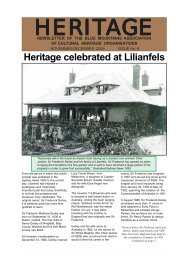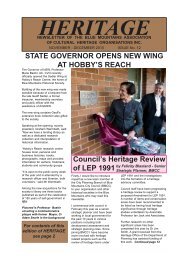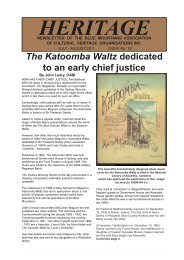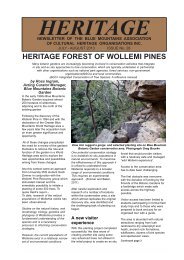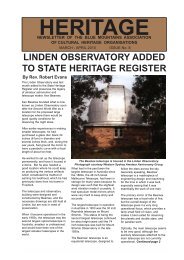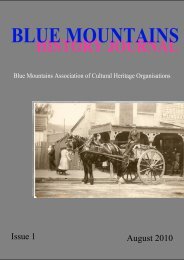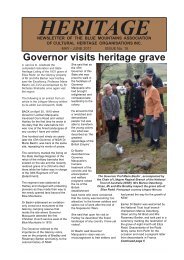Blue Mountains History Journal Issue 3
Blue Mountains History Journal Issue 3
Blue Mountains History Journal Issue 3
You also want an ePaper? Increase the reach of your titles
YUMPU automatically turns print PDFs into web optimized ePapers that Google loves.
<strong>Blue</strong> <strong>Mountains</strong> Historical <strong>Journal</strong> 3;<br />
One journalist gave the distance of the fall as 900 feet (274 m) (Anonymous 1957a), 1,000 feet (305 m)<br />
was reported by Trigger (1980, p.166), Green (1981, p.154) and Thomas (2003, p.221), 1,500 feet (457<br />
m) by Green (1981, p.xxii) and even more outrageous is the height from which Childe said that he<br />
proposed to fall:<br />
“I know a 2,000ft cliff in Australia. I intend to jump off it.” (Professor W.F. Grimes 14.viii.1979 in<br />
Daniel 1980, p.1; Higham 2011, p.57).<br />
In 1957 the recovery team had to carry the corpse from the bottom of Govetts Leap (c.322 feet asl, 99 m)<br />
to the car park at Govetts Leap Lookout which is (980 feet asl, 299 m) (CMA 1980) a vertical ascent of<br />
c.658 feet (c.200 m) (Low 1984; 1988, p.170) and less than half the estimate of 1,500 feet (457 m) given<br />
in a contemporary report and repeated in subsequent accounts.<br />
- Deduction<br />
Map data ©2012 Google<br />
Figure 5. Barrow Lookout (Red Marker) is 60m<br />
east of the top of Govetts Leap (Green Marker).<br />
The reality is that on 19 October 1957 Professor Childe<br />
jumped or fell from Barrow Lookout (910 feet; 277<br />
metres asl) only 66 yards (60 metres) to the east of,<br />
and 60 feet (18 metres) above the top of, Govetts Leap<br />
waterfall (850 feet; 259 metres asl) (CMA 1980)<br />
(Figure 5). He died after falling for up to 580 feet (177<br />
metres) and on an initial, or subsequent, impact<br />
“...the body was badly smashed and mutilated...”<br />
(Morey in Thomas 2003, p.221)<br />
Over four decades later, Thomas wrote that the body<br />
“Was also incomplete” (Thomas 2003, p.235).<br />
But how did he know for no such statement was made<br />
at the inquest?<br />
In February 1959, botanist Ernie Constable was looking for rare plants in the spray area of the waterfall<br />
when he discovered some human remains and personal effects“..., Up on one of the ledges,...” (Low<br />
1984; 1988, p.170) so seemingly above the base of the falls. Hence these came from a body that failed to<br />
reach the base of Govetts Leap, but quite where it ended up is unclear for the precise location of the ledge<br />
in question was not recorded. But were they remains of Gordon Childe as Constable inferred (Low 1984;<br />
1988, p.170)?<br />
● Who informed the Police in 1957?<br />
Initially, driver Newstead was reported (Anonymous 1957a) to have informed the police that Childe had<br />
not returned to his taxi, and in his sworn statement Senior Constable Morey confirmed that indeed<br />
Newstead had reported the disappearance “At about 2pm ...” (Thomas 2003, pp.219-220). However one<br />
contemporary newspaper report included:<br />
“Then a Sydney visitor to the leap, Mr. Brian Darragh, found the professor’s compass and personal<br />
Belongings at the top of the cliff and notified Blackheath police.” (Anonymous 1957b).<br />
so the latter part of that sentence must be a case of journalistic error!<br />
41




